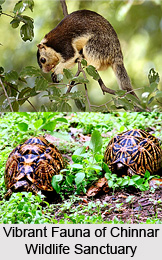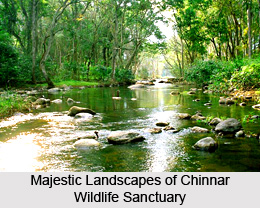 Chinnar Wildlife Sanctuary, located 18 kilometres north of Marayoor region of Devikulam Taluk in the Idukki district of the south Indian state Kerala, is enlisted amongst the protected areas of the state. The sanctuary comes under the jurisdiction of Eravikulam National Park and also shares the boundary with the same towards the south. Towards its east Kodaikanal Wildlife Sanctuary is situated while Indira Gandhi Wildlife Sanctuary is towards its north. It has also been under consideration for being a World Heritage Site by the UNESCO World Heritage Committee. Inside the sanctuary 112 tribal settlements are there, all demarcated with temporary stone walls. Pulayars and Muthuvas are the main inhabitants. It is also famed for sheltering the second largest population of Grizzled Giant Squirrels, an endangered species, in the world.
Chinnar Wildlife Sanctuary, located 18 kilometres north of Marayoor region of Devikulam Taluk in the Idukki district of the south Indian state Kerala, is enlisted amongst the protected areas of the state. The sanctuary comes under the jurisdiction of Eravikulam National Park and also shares the boundary with the same towards the south. Towards its east Kodaikanal Wildlife Sanctuary is situated while Indira Gandhi Wildlife Sanctuary is towards its north. It has also been under consideration for being a World Heritage Site by the UNESCO World Heritage Committee. Inside the sanctuary 112 tribal settlements are there, all demarcated with temporary stone walls. Pulayars and Muthuvas are the main inhabitants. It is also famed for sheltering the second largest population of Grizzled Giant Squirrels, an endangered species, in the world.
Geography of Chinnar Wildlife Sanctuary
Chinnar Wildlife Sanctuary receives an average rainfall of 500 mm for just a few days and lies in the rain shadow region of the southern Western Ghats. It enjoys an altitude ranging from 400 meters at eastern end of the Chinnar River to 2,522 meters at Kumarikal Malai peak. Major perennial water source for the sanctuary is served by Pambar and Chinnar rivers.
Flora of Chinnar Wildlife Sanctuary
Chinnar Wildlife Sanctuary has recorded about 965 varieties of flowering plants. Major forest covers at the higher western elevations include wet grasslands, grassland, high Shola trees and south Western Ghats montane rain forests. At mid elevations dry deciduous forests can be seen while the lower eastern edges comprise thorny scrub forests.
 Prime Xerophytic plants in the sanctuary include Opuntia stricta, Prosporis juliflora, Acacia concinna, Acacia leucofolia and Acacia Arabica. The place also hosts the Marayoor Sandalwood forest.
Prime Xerophytic plants in the sanctuary include Opuntia stricta, Prosporis juliflora, Acacia concinna, Acacia leucofolia and Acacia Arabica. The place also hosts the Marayoor Sandalwood forest.
Fauna of Chinnar Wildlife Sanctuary
Chinnar Wildlife Sanctuary is the home to 34 species of mammals including vulnerable Rusty-spotted Cats, threatened Nilgiri Tahr, Monkey, Bonnet Macaque, Common Langur, Sambar Deer, Tigers, Gaur, Indian Elephants, Spotted Deer, Panthers, vulnerable Grizzled Giant Squirrels and many more. Fascinating 245 varieties of avifauna can also be spotted including Yellow-throated Bulbuls. 52 species of reptiles in the sanctuary include Mugger Crocodiles, Indian Star Tortoise, Snakes and many more. 156 species of butterflies also inhabit the sanctuary. Fishes dwelling in the Chinnar and Pambar rivers are Deccan Mahseer, Giant Danio, River-Carp Baril, Garra Mullya Minnows and many others.
Visiting Information
The beautiful Thoovanam waterfall is located deep within the sanctuary forming an important tourist destination. A lofty watchtower in the sanctuary offers a panoramic view of the entire sanctuary along with the majestic mountains situated nearby. Nature walks and trekking are other enchanting experiences in Chinnar Wildlife Sanctuary. Organization and promotion of eco tourism in the sanctuary is done jointly by the Forest Department and the Eco Development Committees (EDCs) of the local tribal communities. Ernakulum, at a distance of 230 kilometres is the nearest railway station whereas Cochin International Airport, 204 kilometres, is the nearest airport.



















